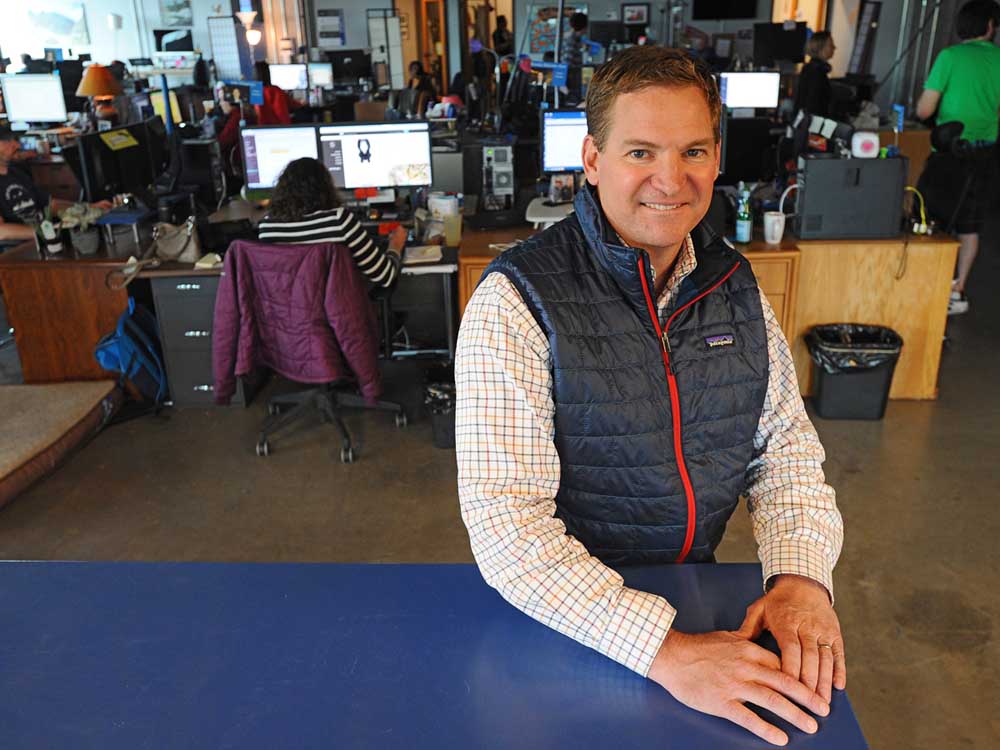Bend company helps build tech ecosystem
Published 12:00 am Sunday, April 17, 2016

- Ryan Brennecke / The BulletinDan Hobin stands in the G5 office in Bend. Hobin and Greg Meier founded G5 in 2005.
Jon Davis was living in Georgia before he moved northwest to Bend in 2009 to take what he described as the best job he ever had.
Davis worked for four years in the paid advertising department at the Bend-based digital marketing company G5, managing monthly online advertising budgets for the company’s clients, which include multifamily housing developments, self-storage units, senior living developments and student housing.
Trending
“It was a growing company,” Davis said of G5. “It felt very startup.”
In his role with the company, Davis started looking for ways to manage advertising campaigns more efficiently. That experience led him to leave G5 in 2013 and found SteadyBudget, a software platform that provides tools for digital marketers, who receive money from clients to promote their companies through a variety of sites such as Google or Bing. SteadyBudget allows those marketers to monitor whether their spending has been under or over budget for each individual advertising campaign.
In 2014, G5 began using the very software that its former employee left the company to build, and Davis said employees reported saving up to 10 hours of work per week.
“I always said I wanted to create the type of product that, if I had had it, I would have never left,” Davis said.
SteadyBudget is one of several instances of former G5 staffers leaving the company to contribute to Bend’s burgeoning technology economy in other roles. Chris Kraybill, now the chief technology officer at the Bend biotechnology company Amplion, worked in the same role at G5 for seven years and joined the smaller Bend company in 2014.
“I love solving the problems that small companies that want to be big companies have,” Kraybill said Tuesday.
Trending
More recently, Lewis Howell, who served as G5’s vice president of information technology for more than four years, left the company in October to found Hueya, a startup that helps individuals monitor their online security.
While Bend has a growing startup scene, it has historically lacked large legacy technology companies such as Apple or Intel, which can provide local tech communities with stable jobs that can accommodate families and a labor pool that startups can then draw from, according to Andrew Nelson, associate professor of management at the Lundquist College of Business at the University of Oregon.
“If you want to build a strong startup community, you need some nonstartups,” Nelson said.
While Bend’s technology community is still young compared with that of larger cities, G5 and other larger companies are beginning to fill that void.
G5’s role
G5 was founded in 2005 by Dan Hobin and Greg Meier. Hobin said the company began by working with self-storage companies because his family worked in that industry. Hobin said the company’s success in early years was primarily self-funded, until the company raised $15 million in private equity in 2010.
Kraybill, who joined G5 in 2007, recalled the rapid growth from that period, saying the company was more than doubling its revenue each year.
Today, Hobin said G5 has around 200 employees, with an eye toward doubling its number of employees and quadrupling revenue within the next three years. While he acknowledged that losing talented people to startups can be a challenge, he said the company is big enough to overcome it.
“We’ve got great people, and I think there will be a lot of companies that will want to spin out of here,” Hobin said.
In an area with rising housing costs and limited higher-education options to bring in outside talent, startups can find it difficult to attract software engineers and other employees. Brian Vierra, venture catalyst at Economic Development for Central Oregon, added that larger tech companies like G5 both have more resources to bring in employees, and provide a valuable safety net for employees who move to Bend, ensuring there are stable jobs in the tech economy even if a startup folds or downsizes.
“It’s a risk to move to Bend, to buy a house here,” Vierra said.
Additionally, Nelson said larger companies can play an important role in training talent. Davis praised G5’s training program, which emphasizes mentoring from other employees.
“It’s almost like a mini-university,” Davis said.
After Davis founded SteadyBudget, he brought over other G5 employees to fill roles at the startup. Chris Vlessis, now the chief technology officer at SteadyBudget, began as a high school intern at G5. SteadyBudget employees Dominic Albano and Tyler Juhola also worked at G5.
“Having a linchpin in the community like G5, that can employ 25 to 30 software developers, is huge,” Davis said.
Hueya’s Howell added that being part of G5’s network of employees and former staffers gives him access to advice and experience. Howell said G5’s Meier, who left the company after the latest round of funding in 2015, now sits on Hueya’s board of advisers.
“I feel comfortable reaching out to anybody at G5 about anything,” Howell said.
G5’s legacy
Furthermore, former staffers are incorporating elements of their time at G5 into other companies. Kraybill praised the workplace culture at G5, which emphasizes staying agile without being too corporate.
“When you walk the halls over there, it still feels like a startup,” Kraybill said.
G5 was one of two Bend companies — along with Deschutes Brewery — to make Outside Magazine’s list of 100 best places to work in 2015. Hobin said the workplace culture was organized around a list of five central values, such as “dare to delight.” When Kraybill came to Amplion, he said he borrowed from that list, collectively called “Five to Thrive.” He added that one of the borrowed values was to emphasize the importance of a company’s customers over the company itself.
“If you come into our office, it’s certainly not the same as G5’s,” Kraybill said. “But it’s creating that culture and values that shape you as a company.”
G5 had an impact on Hueya’s development as well. Howell said Hueya grew out of a lifelong interest in online security, but added that working at G5 gave him insight into how severe some of the threats to that security can be.
“The more I got to understand what’s going on behind the scenes, the more I realized how vulnerable we all are,” Howell said.
Howell said Hueya is preparing to launch the beta version of its software later this spring.
Challenges still remain for Bend’s startup scene. Nelson, from the Lundquist School, warned that large technology companies sometimes stop functioning as an incubator after a while, as years of stability at a company can stifle creativity.
“Innovation dies when you keep doing the same thing,” Nelson said.
He added that a certain amount of churn within a local tech cluster is natural and helps maintain that creativity when new companies incubate talent. For his part, Howell said he is already looking at the legacy that his recent startup could create down the road, continuing the cycle of new companies in Bend.
“My success will be determined by the people that leave Hueya to pursue their own passions,” Howell said.
— Reporter: 541-617-7818,
shamway@bendbulletin.com








